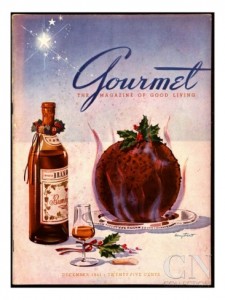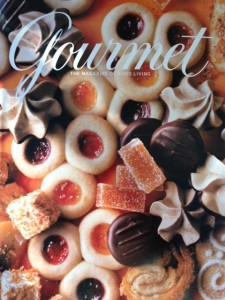 December, time of great nostalgia.
December, time of great nostalgia.
Can we all agree that sometimes we need to exaggerate a point to make a point? This is somewhat akin to my thesis that the greatest pioneers often reach for the stars when setting out, knowing that they will have to take a few steps back in the process, perhaps then settling precisely upon their intended objective. https://kitchen-inspirational.com/2014/09/22/food-markets-florence-2/ When is overreaching and exaggerating a useful methodology?
I am taking a moment this morning to consider the vast breadth and depth of efforts around the world devoted to the preservation, protection and conservation of the world’s greatest art treasures. In 2014, UNESCO protected no less than 1007 sites, we have innumerable museums, foundations and other provisionary organizations whose missions are to ensure that art treasures will never be destroyed. I would not even begin to know how to add up the amount of money that falls within these three definitions – preservation, protection and conservation. And, yet?
Ok, so that’s a pretty stretching statement, no? It has been 5 years since the ending of Gourmet Magazine.
My opening statement just sets the stage for my somewhat more narrow area of focus – a decision that has stuck in my craw for the entire 5 years since it was announced. I’m thinking of this – When does print media cross over the line from the confines of “publication” or “periodical” and become something else, something inherently more valuable – something worth protecting? Perhaps this post would be more properly named, Principles of Product Identification 101?
Let”s just prefice it to say, no, I didn’t go to Harvard Business School. I haven’t gone through the disciplines required to define me as one of the great minds of business. In fact, my formal education would be considered by most to be somewhat laughable. But, I don’t care. That I don’t consider any of that to be a limit to my very own classification and vision of sound reason and decision-making and ability to forestall great loss is well, my own” issue”, I guess. Pardon the pun.
When should the most brilliant business minds place aside the generally accepted principles of sound financial management, as defined in the great halls of study? Hmmm……. Let me see here, I don’t think I am the only one who would agree with the tenets of this particular “case study”.
While it is not just at this time of year, December is a time when I always reminisce about the loss of Gourmet Magazine. I have carried back issues with me from the time I was married (35 years) – and before. And yes, I brought many a box with me as part of my dowry – (haha). They reside in my attic. A few, like the one pictured above, are in the “active” archives.
There are several iconic covers I have stuck in my mind. But, this one is particularly memorable. As I spend time now re-reading this issue, I remember just how great this magazine was. But, what happened?
We all know what has and is happening to print journalism. We are all very well aware of the digitalization of media and reading materials. And while the sale of cookbooks rages on, telling us that the demand for the tangible remains alive and well, the periodical market continues to shrivel. Just this last month, the debut of cookbooks was quite remarkable. Titles raged forward from the likes of Dorie Greenspan, Rose Levy Berenbaum, Gabrielle Hamiliton, Mimi Thorisson, Nick Malgieri, Ina Garten, and on and on. Honestly, even I couldn’t keep up with the releases in early November. The stats are remarkable in the hard-cover genre of food publishing – and herein lies at least part of the quandary. And yet, Gourmet Magazine could not survive.
All of these books and more deserve the great praise they have gotten. But, still, I return to my dog-eared Gourmet magazines – and apparently lots of others do, too.
http://www.lib.umich.edu/news/retrospective-covers-69-years-iconic-gourmet-magazine
I often muse, here and elsewhere, that some decisions should not be made by “the numbers”, a premise that has arisen before. Of course, not a lot of people would agree with me. Those whose lives revolve around metrics-based decision-making remain firmly committed to their “craft”, or should we say, discipline. And yet, “craft” is in fact the word to consider here. The fact that Si Newhouse apparently did not understand the phenomenon that was Gourmet makes me wonder about decision making in so many ways. Of course, there are many a more significant tragedy that is embarked upon in the world these days, but I’m trying to keep this discussion in the genre in which it resides.
The number one failure in this particular instance was to improperly classify Gourmet in the world. The first and most salient mistake was to not clearly see what Gourmet had become. And here, I would venture to say that the powers that be at Conde Nast would never consider folding say, Vogue, ever. Of course, I understand that Vogue stands on its own financially and generates financial benefit so far beyond its print image that it may be impossible to quantify. Yes, I get that. But, in placing Gourmet in the narrow category of food magazine was the first and perhaps most deadly mistake. What the decision-makers failed to consider let alone grasp was that Gourmet was, as is Vogue, far beyond the definition of magazine.
Did its top line and bottom line justify its existence? Perhaps not. But, should it have been ended, merely on this basis? I think not. That this decision could have been made in regard to metrics alone is tantamount to throwing the baby out with the bath water. In fact, the decision-makers so misread the Gourmet phenomenon that they reduced it to the model that ultimately replaced it, what we now see as the current day Bon Appetit. Oh dear. And, I go as far as to consider the faux pas of having people intimately unfamiliar with their product making life and death decisions about it, to be, if not only counterintuitive, well, just plain sad. But, then again, conventional practices would direct one to think that it’s better to remain purely objective.
I once sat on a plane and eavesdropped on a passenger across the aisle who was preparing a presentation for a drug proposal. The hair stood up on my arms as I considered that some life or death decisions could be made based on the efficacy of perhaps this man’s success in some conference room somewhere the next day. Such is the power of pure metrics-based decision making. Perhaps we should consider the plight of Sir Alexander Fleming or Jonas Salk in this regard. You get the point. Just extrapolate.
As I have often said before, one of the most profound learning experiences during my tenure at Pastry School, was to be smacked in the face with the reality of all the 20-somethings and a few 30 somethings that were my classmates. They didn’t read the food section of the New York Times every Wednesday and they didn’t know who Craig Claiborne and Pierre Franey were, let alone Escoffier. And, most of them never would. They watched “Cupcake Wars” and thought that was food tv. So, ok, that being said, the real question is, could Gourmet Magazine be resurrected and be relevant today and forward? I say yes. Because for me, this particular art form is timeless and relevant for all ages.
Ok, so let’s get to the pivot point here. Question is, can you imagine the art in the world that we would NOT have if the artists (or their “managers”) had sat and considered the metrics and potential financial outflows of their vocation, their passion, their imaginations, their impulses – prior to making the decision to take up brush, pencil, chisel, etc. – as if a cost/benefit analysis should be done to determine whether the project should go forward? Just take a moment and think about this. Many would scoff at my reference here. But, I maintain that Gourmet Magazine, despite it’s obvious highs and lows, was in a category that deserved to be considered outside of the realm of other print magazines in the food genre and in the print genre in general and was not. Placing it into the hands of the, um, experts, in this case McKinsey who successfully fed, up the line, their brand of expertise, was indeed a tragedy. What was lost here was so much more than a one instanced lapse of judgment.
Many would even take issue with my classification of Gourmet Magazine as “art”. Ok, I’m willing to say I can see this, but let’s just agree that it was incredibly wrong to place it in the category of any other food publication, where it’s inherent value, backwards and forewords was totally misread. You don’t have to call it art or food culture – call it whatever – but don’t just compare it with a general category of food magazine.
And yes, I, maybe a majority of one, think Si Newhouse’s biggest mistake was to not consider that Gourmet was perhaps a genre unto itself. Perhaps it belonged in a quasi art/food culture grouping and was not merely a prototype of present day periodical media to be fused with the old Bon Appetit and become “one” melded food periodical for the new ages……..ugh. A practical if not accurate review of the two periodicals’ readership would have demonstrated that they did not cross markets – and perhaps this was done, reviewed and ignored in pursuit of a place within the flow of magazine doom-dom. How much time, consideration and emotion were put into the decision to truncate Gourmet in favor of the new Bon Appetit? I don’t know. I would have loved to have been in the process. I shake within however, to think that the adage “if no one uses it any more, then, by definition it is obsolete” skims through. Or, even worse, let’s bring this “up to date”. As with UNESCO sites where the rarest of carved or stained images in caves reside, Rembrandts, Renoirs, Michaelangelos,Dalis,Pollocks, and Picassos, among countless others, these adages perhaps just don’t apply.
If you take a look at just a few of these covers, you might begin to get an inkling of what I speak.http://www.gourmet.com/magazine
(images courtesy Gourmet Magazine):
December 1941 – the inaugural year:
just a few others: take a look online – totally worth it!

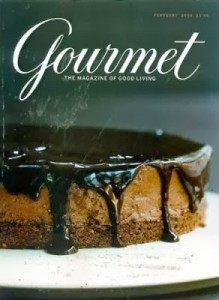
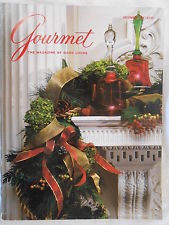
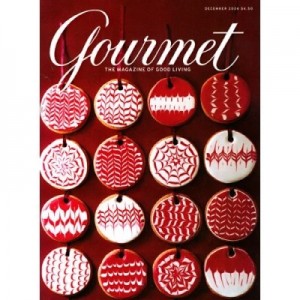
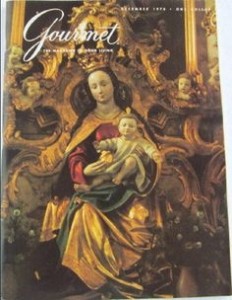
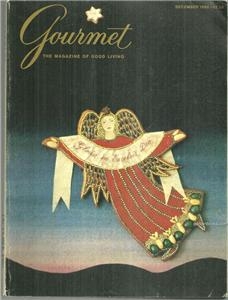 seeing these makes me want to go up into the attic and resurrect each and every one of them – if only I had a place to store these where I could access them on a daily basis.
seeing these makes me want to go up into the attic and resurrect each and every one of them – if only I had a place to store these where I could access them on a daily basis.
What should be said about this debacle? Here a couple of my own little rules for sound decision-making:
– First, business metrics shouldn’t have the top slot place in some decisions – especially when the Company within which they reside is not financially threatened by the viability of one product.
– Second, management and executives need to have a clear and accurate vision of the product upon which they intend to wreak their havoc. This one had gone well beyond the realm of “food magazine”.
– Third, never underestimate the value of the entire scope of effort, vision, craft, and especially, art, that create something irreplaceable.
Well, anyway, yes, I recently read Ruth Reichl’s book, Delicious and it did make me sad. She did a very good job capturing the dedication of the people who worked there and the aura of the entire phenomenon. How close is her story to the Gourmet story? I don’t know.
What I do know is that I find it very difficult to believe that anyone at Conde Nast feels that the surviving publication, Bon Appetit does any justice to the memory of Gourmet as it was intended to be. Perhaps this entire story is a generational notion, as I mentioned above – as is so very much of my nostalgia nowadays. While I believe I have done a decent job in staying on the “current” – to try to stay on the same page as evolving food journalism, I can’t help but feel that something very tangible has been lost – and I don’t just mean in the tactile sense. Could Gourmet be resurrected and be done well? Should it be?
We can all “page” along on the internet, all day long, can’t we? But, let’s all agree here, that this coagulation of product isn’t the same as Gourmet.
Then and Now:
http://www.nytimes.com/2009/10/07/dining/07gourm.html?_r=0
http://blogs.wsj.com/cmo/2014/10/27/cmo-today-new-president-reshapes-conde-nast/
Let’s just say this all indicates the great regard we should have for the people who endure in this “business” and for those who have the vision to keep their endeavors in the realm of a small number of hands. If nothing else today, let’s just hope that a mistake of this magnitude doesn’t happen again as the pressures in the business continue to widdle-down the list of print magazines. And yes, I know, who am I to question the judgment of Si Newhouse? But, so be it. I believe my theory here to be a sound one.
And so, while Gourmet Magazine isn’t in consideration for UNESCO protection, even in my mind, I do believe it has a place other than in the “archives”. In my little world, where I travel each day around all forms of food “media” releases, to take in my fill of muses, photography and prose, ideas and creative efforts and whimsical and razor-sharp experimentation in order to feed my own thirst for inspiration, I again mourn this loss. I do wish that some “visionary” would indeed resurrect this gem, this loss, this art form. For all the private equity endeavors, corporate sponsorships, foundation awards and other forms of “funding”, surely this one deserves to be in the “mix” – on the table, for serious consideration. Of course, this is all the opinion of one.
So, a few things I will try to remember as I go about my day today: as we all live in and embark upon the age of potentially having robots, drones and computers do most if not all of the thinking and decision making in our lives, let us not underestimate the value of what I might call soft human intervention. For, bottom-line (pun intended), it is the wisdom, judgment and human instinct we bring to the thousands of decisions we make every day that differentiates us from all other species and machines. Working to make business school models that project based on numbers and minimize if not eliminate subjective criteria leaves us with something less than fully-formed and optimal. And, if most if not all human-quality is taken from the equation, we all become subject to all that is just plain less human if not less valuable to the human experience. Want a metrics-driven decision? That’s the easy part. Figuring out what to do post data, now that’s the inspirational, and yes, irreplaceable part. That’s just my take.
Ok, I’ve droned on long enough here (pun intended) Now back to my tactile and literal paging……… and then, after all of that, the thought occurred to me – maybe I missed the point of my own whole post here – that when an object of food culture is allowed to pass through its own life cycle and becomes an object within the archives, that it is in fact taking its own distinct place in the continuum. I for one don’t really want to accept this as being a truism – but it was, and has. There is surely nothing I can do about it now but continue to benefit from the work they did from 1941 to 2009. That is my pragmatic self talking – not the one who argued for another outcome.
(don’t you just love puns?)
